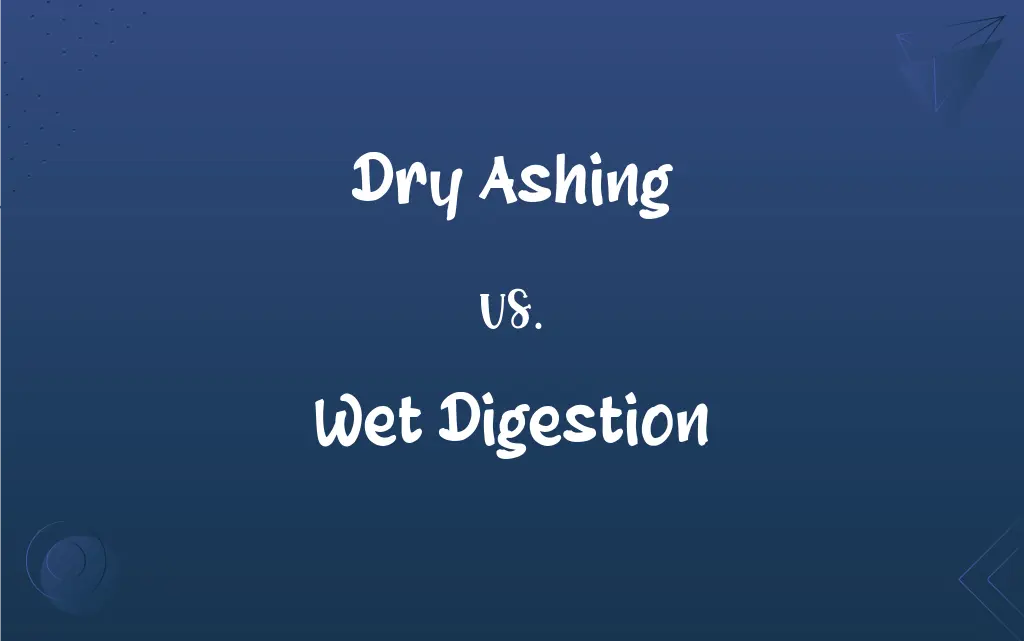Dry Ashing vs. Wet Digestion: What's the Difference?
Edited by Aimie Carlson || By Janet White || Published on February 3, 2024
Dry ashing involves heating samples to high temperatures to remove organic matter, while wet digestion uses chemicals to dissolve sample components in solution.

Key Differences
Dry ashing is a technique where samples are heated in an oven at high temperatures to remove organic matter and volatilize certain components. Wet digestion, on the other hand, involves breaking down the sample using a combination of acids and heat, often in a closed system to prevent loss of volatile elements.
Dry ashing is commonly used for samples with high mineral content and for applications where volatilization of components is acceptable. Wet digestion is preferred for samples sensitive to high temperatures and where recovery of volatile elements is crucial.
Dry ashing requires a muffle furnace and is performed at temperatures up to 500-600°C, posing a higher risk of burns. Wet digestion uses acid-resistant equipment and carries risks associated with handling strong acids.
Dry ashing is a time-consuming process, often taking several hours to complete. Wet digestion is typically faster, though it can vary depending on the sample and acids used.
The end product of dry ashing is an ash residue, suitable for analyzing inorganic elements. Wet digestion results in a liquid sample, ideal for comprehensive analysis of both organic and inorganic components.
ADVERTISEMENT
Comparison Chart
Process
Heating in an oven to high temperatures
Breaking down sample with acids and heat
Sample Suitability
High mineral content, less volatile components
Sensitive to high temperatures, volatile components
Equipment and Safety
Muffle furnace, risk of burns
Acid-resistant equipment, handling of strong acids
Time and Efficiency
Time-consuming, several hours
Faster, efficiency depends on sample and acid used
Analysis Suitability
Ideal for inorganic elements
Suitable for both organic and inorganic components
ADVERTISEMENT
Dry Ashing and Wet Digestion Definitions
Dry Ashing
Dry ashing involves heating samples at high temperatures.
We use dry ashing to prepare mineral samples for analysis.
Wet Digestion
Wet digestion uses acids to prepare samples.
Acids in wet digestion help in decomposing the sample efficiently.
Dry Ashing
Dry ashing produces an ash residue.
After dry ashing, we analyze the ash residue for elemental content.
Wet Digestion
Wet digestion is ideal for comprehensive analysis.
For a complete nutrient profile, wet digestion is the preferred method.
Dry Ashing
Dry ashing prepares samples for inorganic analysis.
For inorganic nutrient analysis, dry ashing is our first step.
Wet Digestion
Wet digestion breaks down samples using chemicals.
We employ wet digestion to dissolve complex sample matrices.
Dry Ashing
Dry ashing volatilizes certain sample components.
Dry ashing helps in volatilizing unwanted substances from the sample.
Wet Digestion
Wet digestion results in a liquid sample.
After wet digestion, we analyze the liquid solution for various elements.
Dry Ashing
Dry ashing removes organic matter from samples.
Dry ashing effectively eliminates organic components in our soil samples.
Wet Digestion
Wet digestion preserves volatile components.
Wet digestion is essential for retaining volatile nutrients in our analysis.
FAQs
What types of acids are used in wet digestion?
Commonly nitric acid, sulfuric acid, or a mixture of acids.
How high are the temperatures in dry ashing?
Typically up to 500-600°C.
Can wet digestion analyze volatile elements?
Yes, it's suitable for analyzing both volatile and non-volatile components.
What is dry ashing used for?
For removing organic matter and preparing samples for inorganic analysis.
How long does wet digestion take?
It varies but is generally faster than dry ashing.
Is dry ashing environmentally friendly?
It can emit fumes and requires energy, so it's less eco-friendly compared to wet digestion.
Is dry ashing suitable for all sample types?
It's best for mineral-rich samples and less suitable for volatile-rich samples.
Can dry ashing analyze liquid samples?
Liquids are usually evaporated first before dry ashing.
Is wet digestion suitable for temperature-sensitive samples?
Yes, it's better for samples sensitive to high heat.
Can dry ashing be used for organic analysis?
No, it's not suitable for organic compound analysis.
What equipment is needed for dry ashing?
A muffle furnace and appropriate heat-resistant containers.
Can wet digestion be automated?
Yes, there are automated systems available for wet digestion.
What types of samples are best for wet digestion?
Organic-rich samples or those requiring volatile component analysis.
How is accuracy compared between the two methods?
Wet digestion generally provides more accurate results for a wider range of elements.
Are there any alternatives to these methods?
Yes, other methods like microwave digestion are also used, depending on the sample and analysis required.
Can wet digestion handle solid samples?
Yes, solids are broken down into liquid form for analysis.
Are there safety concerns with wet digestion?
Yes, handling strong acids requires proper safety measures.
Does dry ashing destroy organic compounds?
Yes, it volatilizes and burns off organic compounds.
How is the residue from dry ashing handled?
It's typically dissolved in acid for further analysis.
Is training required for wet digestion techniques?
Yes, proper training is important for handling acids and equipment.
About Author
Written by
Janet WhiteJanet White has been an esteemed writer and blogger for Difference Wiki. Holding a Master's degree in Science and Medical Journalism from the prestigious Boston University, she has consistently demonstrated her expertise and passion for her field. When she's not immersed in her work, Janet relishes her time exercising, delving into a good book, and cherishing moments with friends and family.
Edited by
Aimie CarlsonAimie Carlson, holding a master's degree in English literature, is a fervent English language enthusiast. She lends her writing talents to Difference Wiki, a prominent website that specializes in comparisons, offering readers insightful analyses that both captivate and inform.






































































